Photography and archaeology at the Société Jersiaise – excavating the archive: an initial study
A seemingly inconsequential enquiry in my first month of employment at the Société Jersiaise Photographic Archive (SJPA) set me off on a voyage of discovery from which – five years later – I am yet to return.
The enquirer was interested to learn of any uncatalogued photographs relating to the archaeological excavations at La Cotte de Saint-Brélade (La Cotte). Frankly, I had no idea. The uncatalogued negative collection of Emile F. Guiton (1879-1972) seemed as good a place as any to start. Emile photographed the site over the first five decades of the 20th century. His first involvement with La Cotte is reported to have been in 1895, but there are surviving photographs by him dated 1905-1955. Reproductions of his photographs are found in many published works on La Cotte, and the majority of the photographs of La Cotte, available via the online catalogue are attributed to him.
Emile was appointed the first manager of the Société’s photographic collections in 1927 a position he seems to have held for life. He was also Editor of the Annual Bulletin (19**-63), Honorary Secretary (1932-46) and Honorary Curator of the Museum (1947-66). Emile was central to decision making around the production, retention and use of photography at the Société throughout this period. The Société’s primary collection of photographs is arguably the card file collection; containing photographs mounted on card with accompanying labels. Arranged thematically, users could browse filing cabinets at the Société to view photographs relating various subjects such as Archaeology, Architecture, Geology, etc. As an accomplished photographer and manager of the collection for around four decades, naturally Emile’s photographs feature heavily, they are the spine of the collection. The card files were one of the first to be digitised and catalogued, so a decision to focus processing efforts on other collections was understandable, there were approx. 1000 of Emile’s photographs available to users via the online catalogue, largely digitised from the card file collection.
My presumption was that his negatives would correlate with the reproductions of his work available from other sources, at least any that were of research value. However, it turned out his negative collection totalled approx. 2500 and a significant number of the La Cotte negatives were not reproduced elsewhere.
In Photographing Tutankhamen, Christina Riggs argues that archival and photographic practices in archaeology are inseparable and that the ongoing care of the resulting archive underpins professional structures and values. In such case, what structures and values did these ‘rejected’ negatives under pin? What could could they tell us not only of the excavations, but about Emile the photographer and the use of photography in archaeological work at the Société Jersiaise?
This preliminary study focuses on a very limited of set of these negatives, 33 , made by Emile, at, or of objects removed from La Cotte between the years 1914-1917. All but one are gelatin silver on glass and other being gelatin silver on cellulose-nitrate film. We will consider these negatives in relation to sources documenting reproduction and use during Emile’s lifetime; the published works on the excavations at La Cotte which start in 1911; and the card file collection which began in 1927. Of the 33 negatives we are considering, 20 were not reproduced in either of these sources, or any other known source.
Editors note.
The following is adapted from talk originally given at the Société Jersiaise in 2019.
Image captions: follow the format Box#/Neg# – Date – Pub.Year – CardFile#
Images will be referred to by the Box#/Neg# in the text.
Date format used reflects the level of detail available on the negative description.
Pub.Year is recorded if the negative was reproduced in a published work and references the year in which it was first published.
CardFile# is provided if the negative was reproduced in the card file collection.
1914 – excavating across the entrance of the north ravine
In 1923, Arthur Mace described photography as ‘the first and most pressing need’ in recording a site before items are removed. Archaeological sites have been the subject of photography since its first formative years. However, it was only during the first decade of the 20th century that archaeologists such as John Garstang pioneered the use of photography as tool for recording excavations in a systematic manner. The excavation lasted a total of 48 working days in 1914. However, Emile, the ‘photographer-in-chief’ made only eight photographs on site during this period, suggesting photography was not a regular feature in the excavation process. So what was photography being used for? A telling indication can be found in R. R. Marett’s, The Site Fauna and Industry of La Cotte de St Brelade Jersey, published in 1916, in which he thanks Emile for helping to, ‘make our results intelligible by way of the eye’. There is clear suggestion from Marett, that Emile was not there to record archaeology in a systematic manner, nor to document work as it progressed, but to represent outcomes visually.
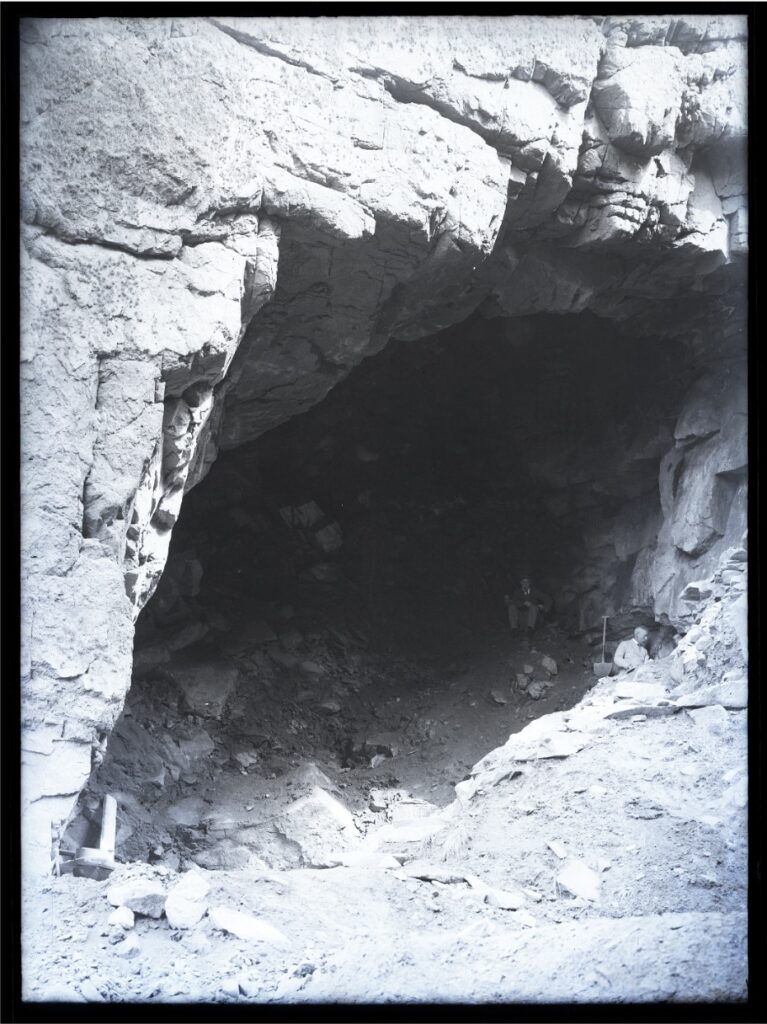
This is likely the first image made by Emile at La Cotte in 1914. Work began in early March, the intention being to excavate across the entrance of the north ravine. From the western side previously excavated in 1910-11, to the eastern wall. Emile sets the scene for us after Earnest Daghorn and his quarry men have already spent five weeks clearing debris, to provide a safe working area at the floor level identified in the earlier excavations. In a similar manner to Emile’s published images of La Cotte in 1910, this image provides the viewer with familiar reference points, features in the granite walls with which to orientate themselves. In contrast to 1910, rather that the key figures being arranged outside for a group portrait, here Marett is at work against eastern wall of the north ravine, de Chrustchoff, is perched up on the back wall smoking a pipe and Marett’s son can be seen poking his head out from the overhang of the eastern wall. Their placement has the effect of inviting you to join them and take closer a look.
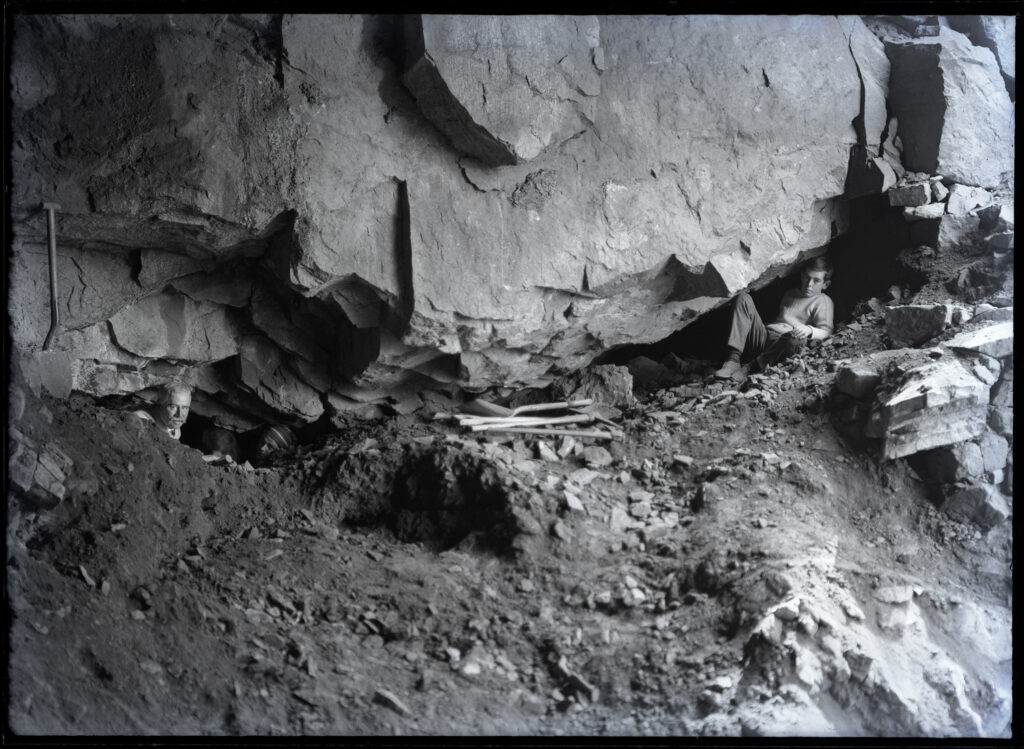
On the 8th April an overhang on the eastern wall was identified, its discovery gets a passing mention in the published reports. Emile is on site only two days later, and one of the two photographs he makes that day shows Marret, de Chrustchoff,, and Marret’s son positioned beneath the overhang. This image has become one of the most iconic ever produced of the work at La Cotte. Yet, it wasn’t published at the time, and understandably so, if the intention of photography is to illustrate outcomes. So what if any purpose did this image serve? Were those working on site simply indulging Emile, allowing him compose this enigmatic group portrait for his own use?
The negative was reproduced in the card file collection. As mentioned above this collection dates from 1927 when first cabinet was purchased and Emile appointed to manage it. This became the primary method of accessing photography at the Société. Photographs being produced, mounted, labelled, indexed, catalogued and stored in systematic manner for ease of retrieval. It is important to understand when a card file was produced for it inform our understanding of the use photography at the Société at any particular time. The date of production is not listed, however the material properties of the mount and two surveying catalogues of the collection can be used to give us indication of when a card file was made.
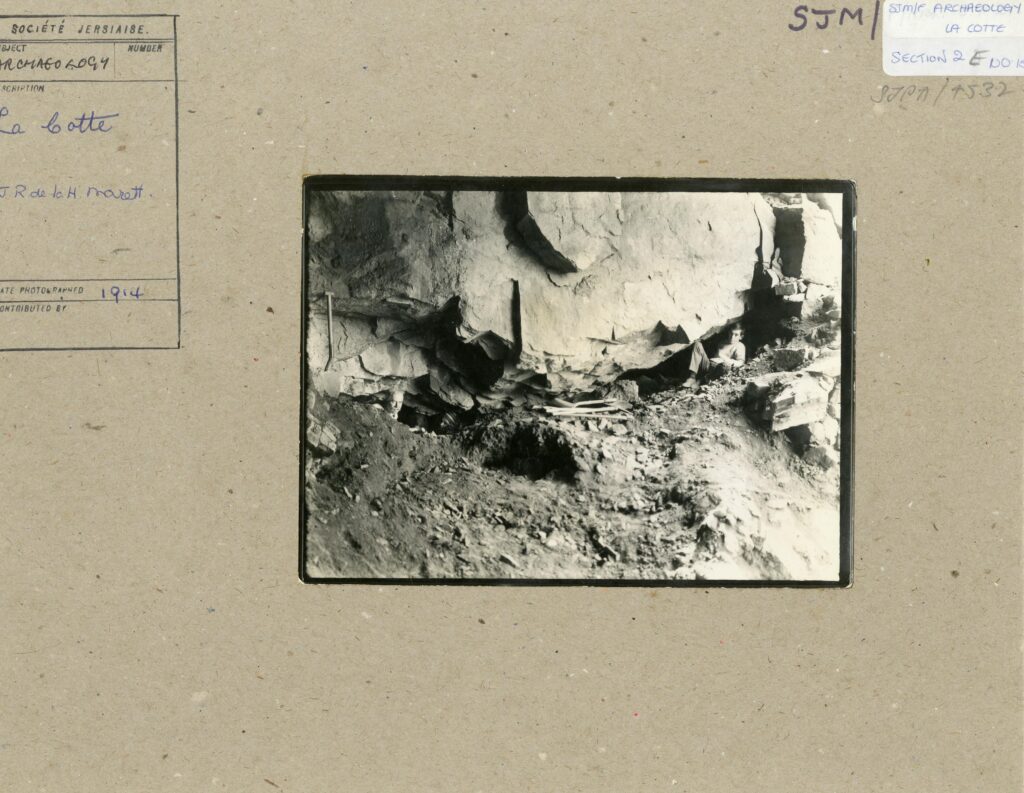
The first catalogue is Emile’s hand written note book dating from the late-1930s. The second is the typed catalogue dating from late-1950s or later. The image above (206/18) is not obviously listed in either. Furthermore the board used to mount this photograph is consistent with board used for other photographs all dating from the mid-1960s and later. It is therefore likely this card file was not produced until over half a century after the photograph was made. Towards the very end of Emile’s life or even after his death. Its earlier omission from both the card files and published works is an indicator of its perceived value. Even when the card mount is produced, there is no reference to the specific location, date or even all subjects. The image served as symbol of the nature of the work at La Cotte.
There is an alternative explanation for the production of this image, one which is consistent with Marett’s photographic requirements on site and its early omission from publicly accessible sources. Emile’s negative description provides the clue:
10/04/1914
La Cotte, St Brelade
Discovery of extension of cave, looking east. Crack, showing roof of new cave.
R. R. Marett, B. de Christehoff (sic) and J. Marett.
This description presents the image in a very specific context. That of a notable discovery, a result even, one that may need to illustrated in a report. It is possible Emile’s original negative description evidences an initial belief that the discovery of the 8th April was in fact a ‘new cave’ not an over overhang. It is well within reason that Marett may have wanted to make the opening of the new cave, ‘intelligible to readers by way of the eye’. And, therefore why the negative was quietly filed away when no new cave materialised. A definitive answer as to the purpose is also unlikely to materialise after 110+ years. What we can say with confidence is that 206/18 was not deemed of significant use to those working at the site, nor those responsible for managing the resulting archive, for at least half a century.
slides 25/26/29/30
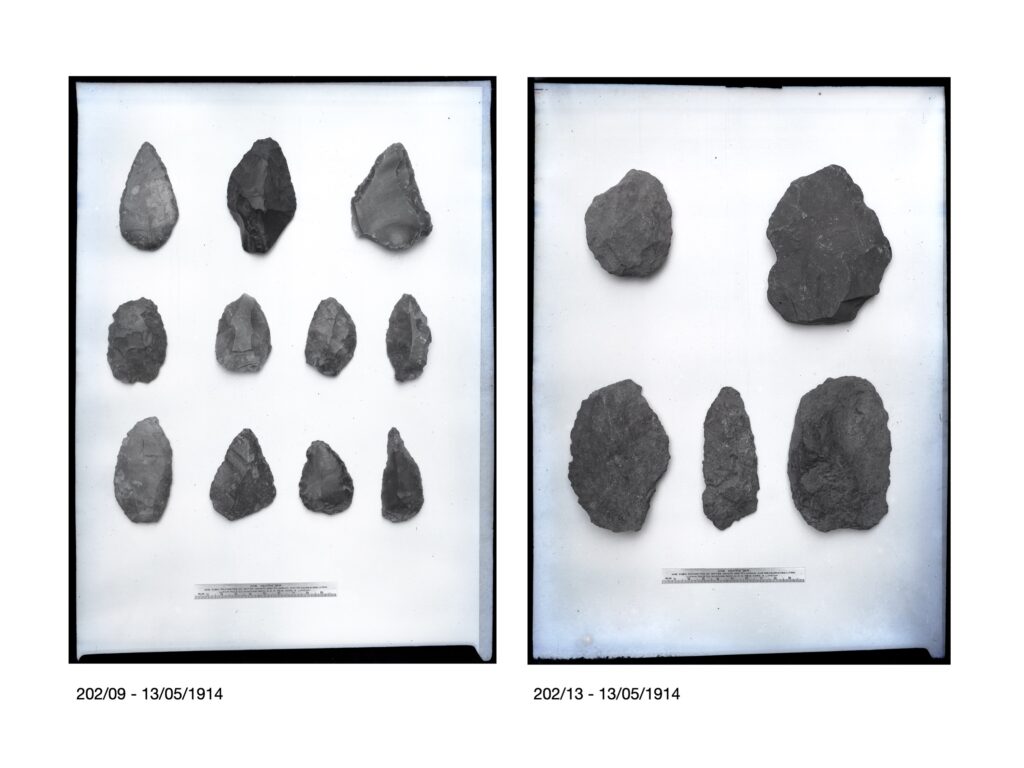
Here we can see Emile applying the conventions that were by then becoming the norm in object photography. Neutral plain background, each object given its own space, with a light source from the top left. For Elizabeth Edwards, these elements evoked a scientific distance that led to object photography being largely overlooked as a genre of photographic practice. The arrangement in typologies brings not only a visual order, but a management system, allowing comparison and study within types. The image on the left was published the following year.
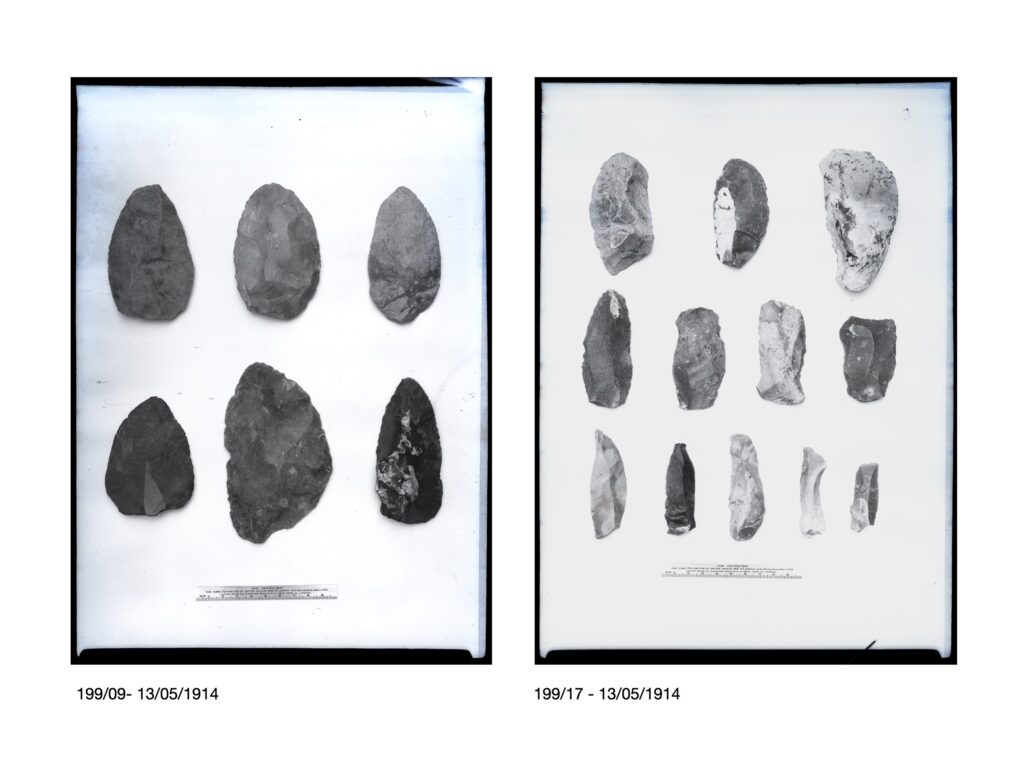
These two were also published in 1915. If we look at the negative descriptions, On the left we have, ‘large points’, on the right, ‘scrapers and knives’. The published image from the figure above this is captioned, ‘medium sized points’. These photographs were clearly produced to illustrate types and variation within type, not to systematically record finds.
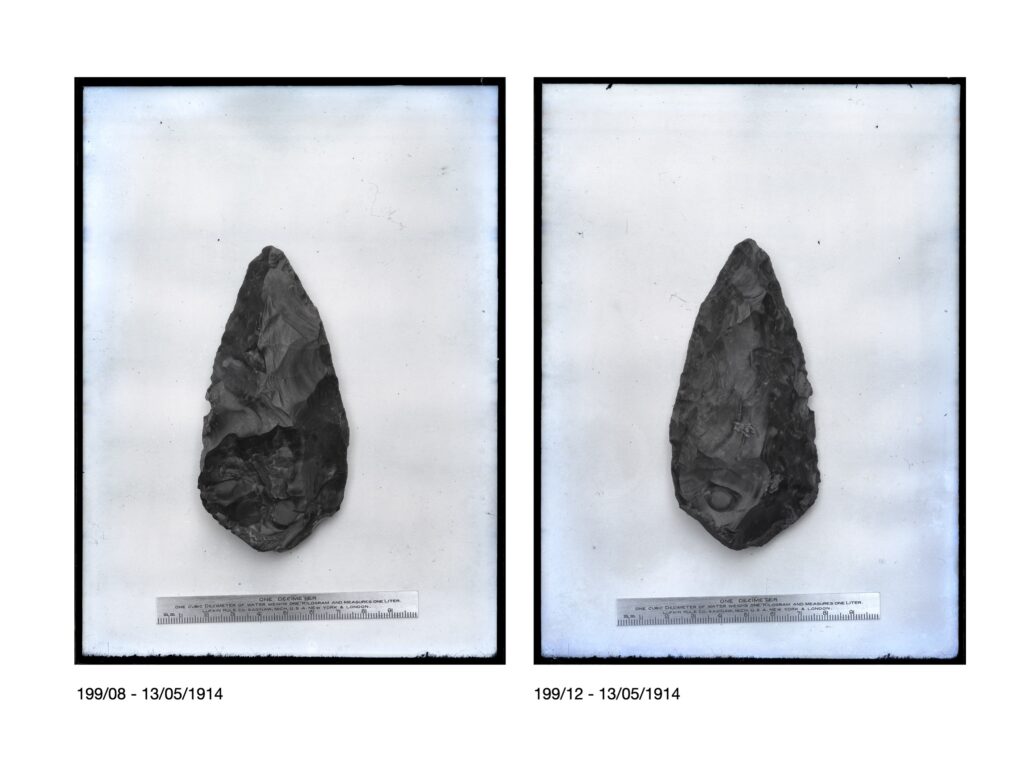
With these two examples, we have something more closely resembling the use of photography to record an object. Being photographed from two sides, we can visualise it as a 3D object. However, the negative descriptions indicate another potential purpose. They refer to the ‘primary flaking’ and ‘secondary chipping’ evident on opposite sides. Were the photographs produced to illustrate this difference? Neither photograph was published, but illustrations were. It is quite possible the photographs were produced to assist the illustrator.
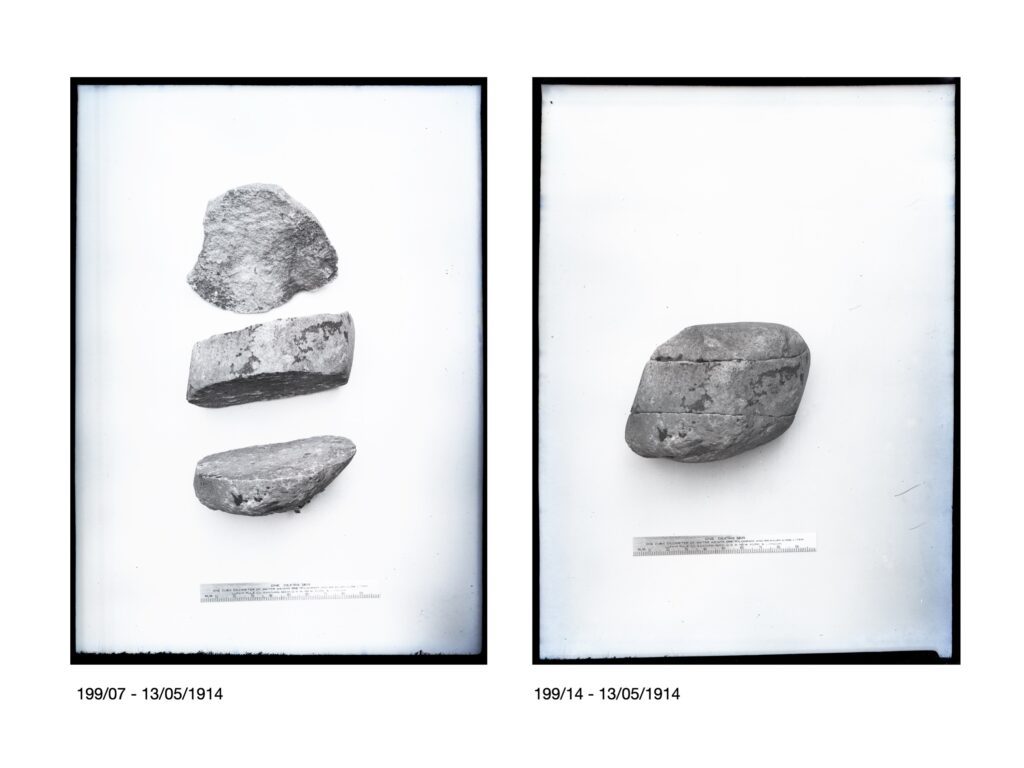
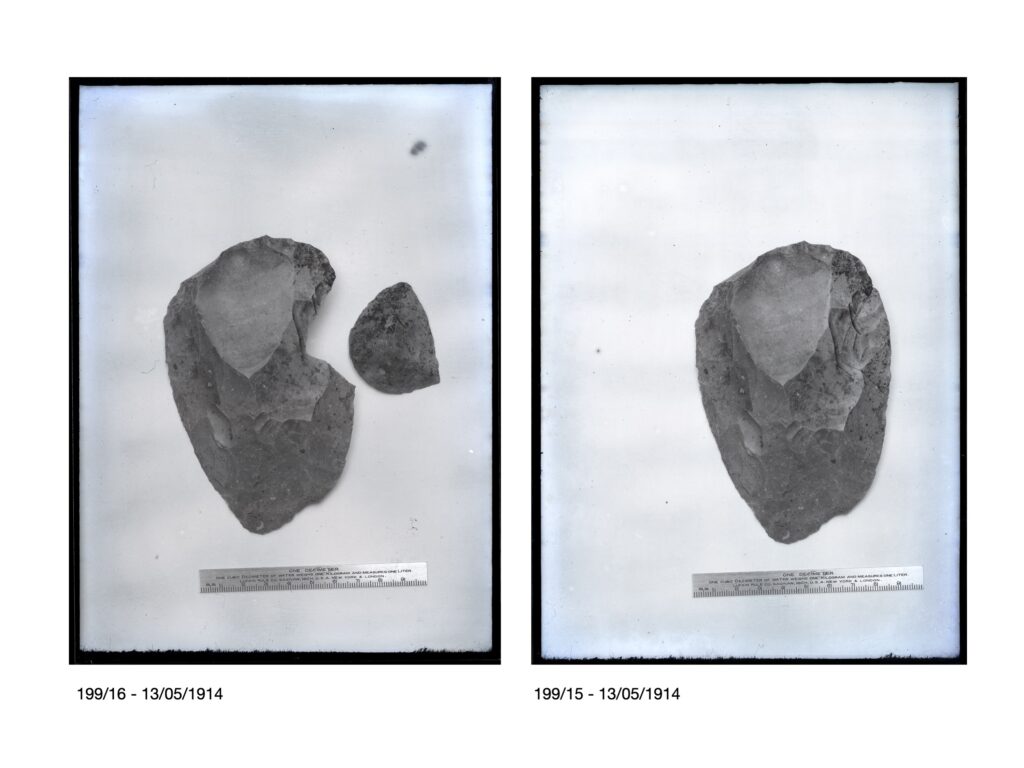
The reports contain references to finds that fit back together, sometimes found some distance apart, here we have two fantastic examples. It was common at the time for finds to be photographed after cleaning and restoration. Howard Cater and Author Mace writing 1923 emphasised that the recording and repairing of objects is essential for archaeologists. And this is exactly the language Guiton uses to caption the images. The second pair being labelled on the left as, ‘large point broken, and on the right, ‘large point restored’
It was clearly important to Emile to record the process. With these images we currently have no image history other than the negatives being produced in 1914, so their exact purpose is still somewhat speculative. I is possible they were meant for demonstration purposes, either in print, or as part of a lantern slide talk. In much the way they are used above, before and after restoration.
1915 – excavating along the eastern wall of the north ravine and the collapse of the roof
slides 36/34/35
For none of the objects photogprahed 1914-15 do we have any ***descriptive meta data *** object numbers, find locations etc.
slides 32/33
1916-17 – clearing the debris and returning to the western wall of the north ravine
slides 39.1/38
slides 39.2-42